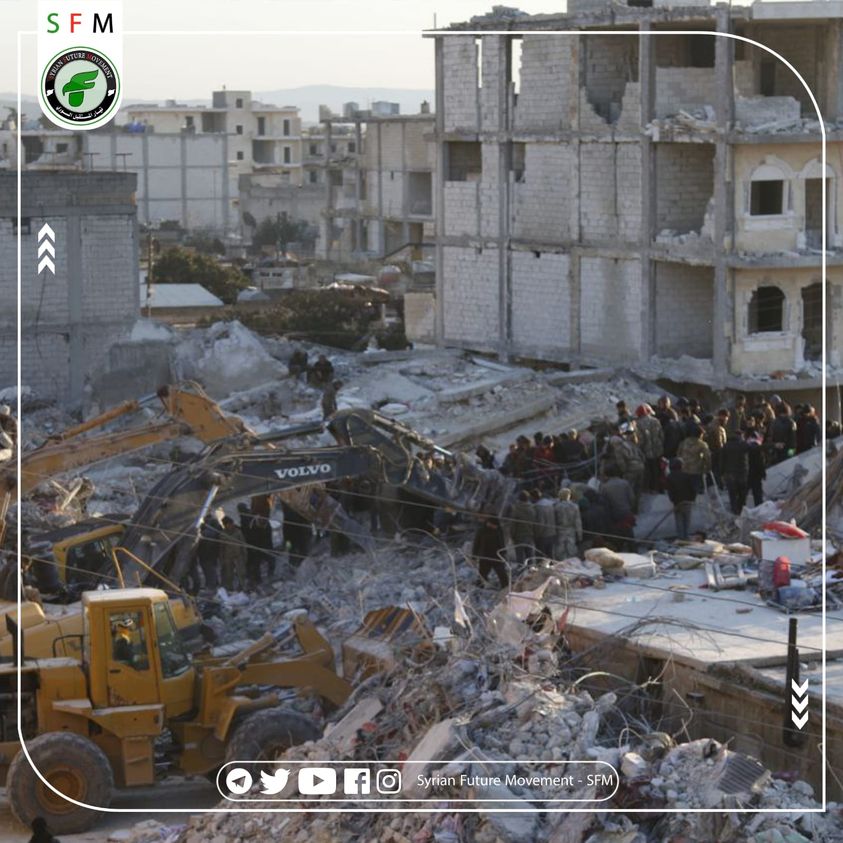A Year After the Earthquake Tragedy: What Have We Done?

The regions of northwestern Syria and southern Turkey witnessed, in the early hours of Monday, February 6, 2023, two earthquakes of magnitudes 7.6 and 7.8 on the Richter scale, almost the strongest in the region’s history. This natural disaster resulted in a tragic loss for 48,000 families (311,662 individuals, with children, women, and special cases making up 67% of them), according to updated statistics by the “Syria Response Coordinators Team”.
More than 51,931 people affected by the earthquake are still in shelters and camps, and according to the Department of Plans Auditing and Structural Reinforcement in the Ministry of Local Administration, the number of buildings completely destroyed in Idlib is 487, and the number of buildings unfit for habitation is 1,457.
The earthquake claimed the lives of over 59,000 people, according to the Associated Press. At least 537 children lost one of their parents due to the earthquake, although only 61 children were recorded as having lost both parents, and reality remains larger than statistics! In the same context, Eva Hinds, a spokeswoman for the United Nations Children’s Fund (UNICEF), stated that about 542 children were found “unaccompanied and separated” after the earthquake across Syria. This is besides the painful physical injuries, not to mention cases of critically injured who lost some of their limbs, as well as psychological conditions that require long-term treatments and are generally not available in the region.

إحصائيات أضرار الزلازل في شمال غرب سوريا وفقا لفريق منسقي الاستجابة لسوريا: المباني السكنية الخاصة:
- Number of buildings demolished during the earthquake immediately: 2,171
- Number of buildings unsafe for return, irreparable, and urgently needing demolition: 5,344
- Number of buildings needing reinforcement to become safe for return: 14,844
- Number of safe buildings needing maintenance: 23,738
- Number of buildings on the verge of collapse that were demolished after the earthquake: 214
Facilities and Infrastructure:
- Educational facilities: 433 schools (partial damage, partial collapse, and moderate damage).
- Health sector facilities: 73 facilities (partial and moderate damage).
- Camps: 136 residential units, with damages ranging from minor to moderate.
- Places of worship: 83
- High water tanks: 13
- Damages in other facilities: 94
Without a doubt, the earthquake is considered one of the disasters of the era in Syria. Therefore, we, in the Syrian Future Movement (SFM), commemorate this anniversary and study the various efforts of the Syrian opposition one year after the earthquake.
Efforts Made:
The five shelters near Jindires remain in their original state when they were established after the earthquake, with no changes except for the relocation of some families to concrete homes in Idlib or Azaz. The reconstruction projects of residential units in the Jindires area are absent, even though it was the most affected by the earthquake in Syria. Meanwhile, organizations have launched a number of early recovery projects and the restoration of hundreds of buildings and some educational and service facilities.
A report by “Syria TV” on the one-year anniversary of the tragedy cited the Directorate of Camp Affairs in the Ministry of Development of the “Salvation Government,” stating that the number of residential apartments constructed for earthquake victims in Idlib reached 1,792, covering only 5-6% of the earthquake victims. About 10,000 families affected by the earthquake were relocated to concrete and prefabricated homes, in cooperation with organizations and humanitarian associations operating in the area, where the relocation of families residing in the 113 temporary shelters established after the earthquake began, except for the shelter in Harim city, where families are expected to be moved to the residential city of Melhem Volunteering Team when construction is completed.
The report mentioned that the reconstruction of apartments and residential units requires international intervention, as the efforts of organizations based on donations will, at best, cover no more than 10%.
وفي وقت سابق، أطلقت المنظمات الإنسانية والفرق التطوعية مشاريع سكنية لإيواء ضحايا الزلزال، أبرزها: فريق ملحم التطوعي، وهيومن نداء، ومحتاجون، وهيئة الإغاثة الإنسانية وحقوق الإنسان والحريات نفذت هذه المنظمات العديد من القرى السكنية لضحايا الزلزال في عدة مواقع، أبرزها: (قرية الزهور) في جبل كيلي بواسطة نداء الإنسان، و (حريم الهلال) في مدينة حارم والشقق السكنية في أرمناز من قبل فريق ملحم التطوعي.
Efforts of the Syrian Future Movement
The Syrian Future Movement (SFM) played an active and participatory role in providing whatever it could from the first day of the earthquake, contributing the following:

- انطلقت اليوم الأول من حملة (تواد1) الإنسانية التي تستهدف ضحايا الزلزال في المدن والبلدات المحررة في الشمال السوري بتاريخ 8 شباط/فبراير 2023، والتي استفاد منها واستهدفت 100 طفل، موثقة على صفحات التواصل الاجتماعي الخاصة بآلية SFM.

- قدم مكتب الإغاثة التابع ل SFM المساعدات لأهلنا المتضررين من الزلزال ، وخاصة النساء ، حيث قدم مبالغ مالية بالليرة التركية ، موثقة على صفحات SFM على وسائل التواصل الاجتماعي.

- وكانت الآلية من بين الفرق الأولى المتواجدة في مكان الحادث في سوريا، وخاصة في جنديرس، حيث قامت بتوزيع المواد الغذائية والوجبات على فرق إزالة الأنقاض والخيام المحيطة، وواصلت SFM وجودها هناك طوال الأسبوع الأول من التأهب بعد الزلزال.

- واصل مكتب الإغاثة التابع للSFM تقديم المساعدات خلال شهر رمضان المبارك، بعد شهرين من الزلزال، لمتضررينا، وخاصة النساء في سوريا وتركيا، حيث قدم مبالغ بالليرة التركية والدولار الأمريكي، موثقة على صفحات SFM على وسائل التواصل الاجتماعي.

- قدم مكتب الإغاثة التابع ل SFM (ضمن حملة تواد الإنسانية) مساهمات حقيقية في نقل بعض ضحايا الزلزال إلى إسطنبول، ثم تأجير منازل لهم هناك، بمبالغ مالية موثقة على صفحات SFM على وسائل التواصل الاجتماعي.

- Dr. Zaher Badrani, President of the SFM, and a large number of official figures, participated on the third day of the public condolence council for the earthquake victims, held in the Arab Traders Council Hall in Istanbul, where he delivered a recorded speech, documented on the SFM’s social media pages.
Chaos and Failure:
Turkey handled the aftermath of the earthquake that struck Syria in several ways, most importantly:
- Shelter: 645,000 tents were installed in Turkey within 350 earthquake-affected areas, while 215,224 prefabricated houses were constructed for the same purpose.
- Search and Rescue: Approximately 30,000 rescue teams, including professionals and volunteers, as well as rescue teams from other countries, reached the disaster-stricken areas.
- Legal Responsibility: Turkish authorities suspected a total of 957 individuals of being jointly responsible for the high number of casualties and significant damages.
- Reconstruction: Turkish President Recep Tayyip Erdogan announced that the government would start constructing homes for 270,000 families in cities and rural areas in 11 earthquake-affected provinces.
- Cost: The total cost of reconstruction is estimated at around 100 billion dollars.
- Humanitarian Aid: Humanitarian assistance was provided to people affected by the earthquake, including food, water, and medical care.
- Employment: Temporary job opportunities were provided for people who lost their jobs due to the earthquake, such as debris removal and reconstruction.
As for Turkey, the neighbor most affected by the earthquake, Ahmed Al Qasim, head of the Central Housing Department at the Ministry of Development and Humanitarian Affairs in the “Salvation Government,” states that the homes to which families were relocated are of two types:
First: Concrete homes, which are the majority, consisting of two rooms, utilities, and an open space.
Second: Prefabricated homes (caravans), with an area of about 45 square meters, where these homes have sanitation services, a road network, and water, bread, and food baskets are provided in some residential villages.
Moreover, engineer Mohammad Yasser Ghazal, the Director of Technical Services at the Ministry of Local Administration and Services, states to “Syria TV website” that the main problems causing the collapse of houses during the earthquake were generally related to the structural elements of the buildings. The lack of sufficient structural elements to withstand earthquakes, such as the absence of shear walls necessary for earthquake resistance, and the absence of studies related to the seismic factors of the buildings before their construction, were contributing factors to the collapse of the houses. He adds that these problems still exist in many buildings constructed in the past in various areas, due to unlicensed construction, i.e., without structural or architectural plans. This construction violates all technical and engineering specifications, in addition to architectural and regulatory violations regarding urban planning, building control system, and building in areas where construction is not allowed, such as streets, parks, service and administrative centers, and agricultural lands.
In addition, contractors or “building traders,” as he describes them, attempt to deviate from the structural plans and reinforcement plans for the building to save on financial costs, constructing with the least possible expenses. They also try to carry out concreting operations without the presence of the municipality or without obtaining the necessary concreting permit to inspect the structural framework, monitor the reinforcement steel, and ensure its compliance with the conditions and the approved engineering plans.
So, we are facing a blatant failure in dealing with the aftermath of the earthquake, which necessitates the true accountability of those in charge of the reconstruction file as a whole!!
Conclusion
The handling by the governments outside the control of the Syrian regime reveals a lack of control and accounting for damages on one hand, and a lack of organization in the matter of reconstruction on the other. This state of chaos points to future risks in case of a recurrence of the earthquake!
Therefore, we in the Syrian Future Movement recommend the following:
- The necessity of holding accountable those in charge of the reconstruction file for their failure in controlling and organizing the reconstruction.
- The necessity of starting to benefit from Turkish efforts in dealing with the reconstruction file.
- The necessity of ensuring that new construction is organized and scientifically studied to protect against the risk of earthquakes, and to seek assistance from Syrian and international engineering offices in this regard.
- The necessity of benefiting from the debris removal sector, especially in the Jindires area, recycling the destroyed structures, and using them in building roads and streets.
- Working on attracting international support for reconstruction in this matter, and cooperating with the United Nations in supervising and implementing it.
- Forming an official entity in liberated Syria, whose role is to monitor these natural risks and the like, and to provide scientific guidance according to the situations to deal with them, warn about them, and guide the necessity and way of avoiding them.
- Forming a national body dedicated to collecting money for reconstruction and communicating with the relevant countries to sign joint agreements with the governments in northern Syria to enhance the reconstruction plan and accelerate the relocation of those affected from scattered and random tents to organized and suitable houses.
- Working with international organizations and others to rehabilitate those affected by the earthquake financially, morally, and psychologically to be active and influential in their country and homeland.
Economic Office
Research and Studies Department
Articles
Syrian Future Movement (SFM)





